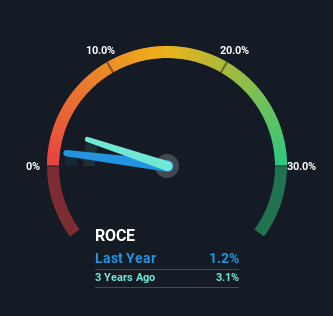- United States
- /
- Software
- /
- OTCPK:AVYA.Q
These Return Metrics Don't Make Avaya Holdings (NYSE:AVYA) Look Too Strong
If you're looking at a mature business that's past the growth phase, what are some of the underlying trends that pop up? When we see a declining return on capital employed (ROCE) in conjunction with a declining base of capital employed, that's often how a mature business shows signs of aging. This combination can tell you that not only is the company investing less, it's earning less on what it does invest. And from a first read, things don't look too good at Avaya Holdings (NYSE:AVYA), so let's see why.
Understanding Return On Capital Employed (ROCE)
If you haven't worked with ROCE before, it measures the 'return' (pre-tax profit) a company generates from capital employed in its business. To calculate this metric for Avaya Holdings, this is the formula:
Return on Capital Employed = Earnings Before Interest and Tax (EBIT) ÷ (Total Assets - Current Liabilities)
0.012 = US$38m ÷ (US$4.3b - US$1.2b) (Based on the trailing twelve months to June 2022).
Therefore, Avaya Holdings has an ROCE of 1.2%. In absolute terms, that's a low return and it also under-performs the Software industry average of 10%.
View our latest analysis for Avaya Holdings

Above you can see how the current ROCE for Avaya Holdings compares to its prior returns on capital, but there's only so much you can tell from the past. If you're interested, you can view the analysts predictions in our free report on analyst forecasts for the company.
What Can We Tell From Avaya Holdings' ROCE Trend?
In terms of Avaya Holdings' historical ROCE trend, it isn't fantastic. The company used to generate 8.9% on its capital five years ago but it has since fallen noticeably. On top of that, the business is utilizing 22% less capital within its operations. When you see both ROCE and capital employed diminishing, it can often be a sign of a mature and shrinking business that might be in structural decline. Typically businesses that exhibit these characteristics aren't the ones that tend to multiply over the long term, because statistically speaking, they've already gone through the growth phase of their life cycle.
Our Take On Avaya Holdings' ROCE
To see Avaya Holdings reducing the capital employed in the business in tandem with diminishing returns, is concerning. This could explain why the stock has sunk a total of 90% in the last three years. Unless there is a shift to a more positive trajectory in these metrics, we would look elsewhere.
If you want to know some of the risks facing Avaya Holdings we've found 5 warning signs (4 shouldn't be ignored!) that you should be aware of before investing here.
While Avaya Holdings isn't earning the highest return, check out this free list of companies that are earning high returns on equity with solid balance sheets.
New: Manage All Your Stock Portfolios in One Place
We've created the ultimate portfolio companion for stock investors, and it's free.
• Connect an unlimited number of Portfolios and see your total in one currency
• Be alerted to new Warning Signs or Risks via email or mobile
• Track the Fair Value of your stocks
Have feedback on this article? Concerned about the content? Get in touch with us directly. Alternatively, email editorial-team (at) simplywallst.com.
This article by Simply Wall St is general in nature. We provide commentary based on historical data and analyst forecasts only using an unbiased methodology and our articles are not intended to be financial advice. It does not constitute a recommendation to buy or sell any stock, and does not take account of your objectives, or your financial situation. We aim to bring you long-term focused analysis driven by fundamental data. Note that our analysis may not factor in the latest price-sensitive company announcements or qualitative material. Simply Wall St has no position in any stocks mentioned.
About OTCPK:AVYA.Q
Avaya Holdings
Avaya Holdings Corp., through its subsidiaries, provides digital communications products, solutions, and services for businesses worldwide.
Slightly overvalued with weak fundamentals.
Similar Companies
Market Insights
Community Narratives



